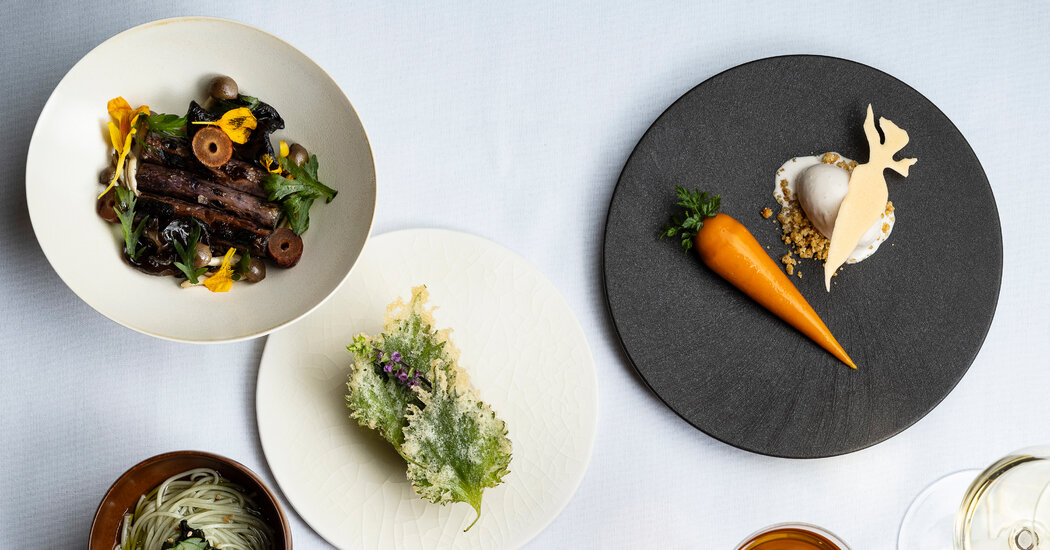
At their groundbreaking restaurant Atomix, Junghyun and Jeongeun Park seem to have the keys to a secret room filled with flavors that New York’s older Korean restaurants barely hint at. Nearly every course on the elaborate tasting menus is made up of a dozen or more ingredients. There are stunning imported vinegars derived from mugwort, birch and cherry blossoms. Kimchi, often made on site, does not stop with cabbage and radishes but plunges into a realm of fermented tomatoes, chiles and mustard leaves.
Some interesting items turn up on the plates at Naro, too, which the Parks — he goes by J.P. and she is called Ellia — have been operating in the Rockefeller Center concourse since October. You can, for instance, eat a sorbet flavored by the fleshy seed stalks of the Japanese raisin tree.
But novelty is not the main point of this younger restaurant. While Atomix tries to expand our notions of what modern Korean cuisine might contain, Naro’s executive chef, Nate Kuester, takes a different tack. His kitchen dives straight into traditional foods, starting with favorites like bibimbap and seafood jeon and reaching back to recipes that predate the 20th century, in ways that make them seem full of unexplored potential.
Naengchae, a chilled salad usually presented with thin strips of vegetables fanned out on a plate, is a mainstay of Korean tables inside and outside the home. At Naro, the naengchae looks like a nest of vermicelli noodles when it shows up. The vermicelli turn out to be threads of kohlrabi, and they sit on top of lumps of king crab, slices of simmered octopus, wheels of watermelon radish and dabs of hot mustard, all meant to be stirred together. There’s something else, too: flaky crystals of radish granita. This is an allusion to mul naengmyeon, cold noodles served in ice-cold, sometimes slushy brine that is used to pickle radishes. It’s a magician’s trick, this salad that turns into noodles that turn back into a salad again.
Another illusion: the one-bite appetizer that looks at first like a piece of kimbap, soft tendrils of bracken fern wrapped in a belt of seaweed. When you eat it, though, you discover that the seaweed has somehow become as puffy and crunchy as a cracker — a version of gim bugak, the fried seaweed snack.
Sanjeok, normally a straightforward skewer of grilled meats and vegetables, is also reimagined at Naro. Sweet soft bricks of butternut squash alternate with lengths of emulsified chicken sausage. It is surely the best chicken hot dog on a stick ever served in a Korean restaurant.
Simpler dishes hold discoveries at Naro, too, like mixed mushrooms stir-fried with pickled burdock and mounded over a bowl of short-grain rice. The mushrooms are seasoned with sesame oil and seeds, and the rice is merely steamed, but very few things I’ve eaten lately have tasted as rare and luxurious. And this is only a side dish. It showed up, with no warning from the menu, alongside a snowy block of halibut in a golden, aromatic broth made from the rice wine cheongju.
You eat all this and more in a spare, incongruously futuristic dining room separated from the concourse by a curving Art Deco glass wall. Black chairs punctuate an expanse of white and off-white panels and banquettes, making the space look something like a set from “2001: A Space Odyssey.” (It may be relevant that Naro-1 was the name of the first South Korean rocket to place a satellite in orbit around the earth.)
A darker shade of paint on the ceiling and the sheer curtains that appeared on the glass wall in April have made the space look slightly less sci-fi. It is not the only change at Naro as the Parks try to adapt their vision of formal Korean dining to an underground mall full of office workers, tourists, commuters and skaters. The price of the tasting menus at dinner (one vegetarian and one not, each with about 11 courses) dropped to $165 from $195. Lunch, which had been a five-course, $95 tasting, now comes in a variety of sizes: two courses for $52, two courses and dessert for $68, and an à la carte menu that runs from $19 to $46.
The Parks have always been skilled at fitting their hospitality style to their interiors. At their first restaurant, Atoboy, which looks like an after-work canteen that might have been designed by Marcel Breuer, the hospitality strikes a gracious, casual tone. The precise but engaging spirit at Atomix sets the standard for tasting-counter service in the city.
Naro aims for a blend of formality and friendliness, and servers are quick with a smile. They’re quick all around, and not always in the right way. Early on, explanations of some dishes were so rushed I am still not quite sure what I ate, and the check was dropped at the same time as dessert; before I’d picked up a spoon, somebody circled back for my credit card.
The pace has slowed, but I still get the sense that Naro, like some of the other new restaurants in the concourse, is still trying to catch the rhythms of Rockefeller Center, where some people come just to look around and others are on their way to some other place.
None of this seems to afflict Naro’s kitchen, which has always been uncannily assured. The pastry chef, Celia Lee, who was last seen at the Modern, puts together sweet meditations that could probably stand alone if the Parks decided to turn Naro into a dessert bar. Her sorbet of hallabong tangerines, a prized product of the island of Jeju, paired with fresh tangerine sections and a fluffy gin-scented cloud of Negroni over jellied Champagne, might even work at one of the city’s more forward-thinking cocktail bars.



